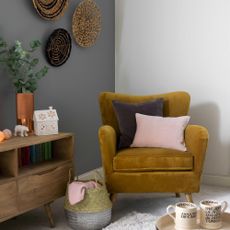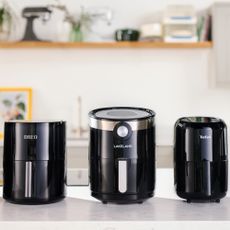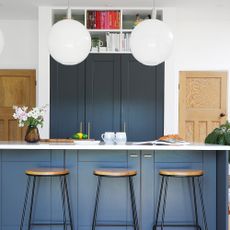Best dehumidifiers – banish damp, mould and mildew in your home
The best dehumidifiers for getting rid of damp in your home – our tried and tested favourites from De'Longhi, Pro Breeze, EcoAir, Russell Hobbs and more


Quick Menu
If you're searching for the best dehumidifier on the market, then it's likely that – like many of us – you're looking for ways to combat damp, mould, or mildew in your home.
Ventilating your house by regularly opening windows is one of the best ways to remove excess moisture from the air in your home, as well as turning on extractor fans in bathrooms and kitchens after showering or cooking. But, these options aren't always possible, and in poorly insulated homes or at times of the year when wet washing is drying indoors, moisture levels can easily creep up and cause damage to both our homes and our health.
A dehumidifier can help improve indoor air quality by extracting excess moisture from the air. Maintaining balanced moisture levels can, in turn, prevent the damp conditions that can lead to the formation of mould or mildew, so investing in a dehumidifier can be a useful way to protect your house from damage, and – like adding one of the best air purifiers to your home – improving indoor air quality can also have health benefits.
In this guide we've tried and tested some of the best dehumidifiers on the market, reviewing each model's extraction rate to see how quickly it can remove excess moisture from the air, its water tank capacity to see how often it needs emptying, the size and weight of the appliance to find the most portable options, plus each model's noise levels, ease of use, and value for money. Read on to uncover the Ideal Home team's best buys.
The quick list
Short on time? This quick list is an overview of the very best dehumidifiers. You'll find more information on each dehumidifierand why our testers recommend it if you keep on scrolling.

Best dehumidifier overall
The best dehumidifier we've tested, the MeacoDry Arete One is quiet, easy to use, works superbly and is very energy-efficient compared to other compressor models. Plus, its Smart Laundry Mode makes it one of the best dehumidifiers for drying washing indoors. There are 10, 12, 20 and 25L models available, and, all offer a built-in air purifier that means they improve indoor air quality in more ways than one.
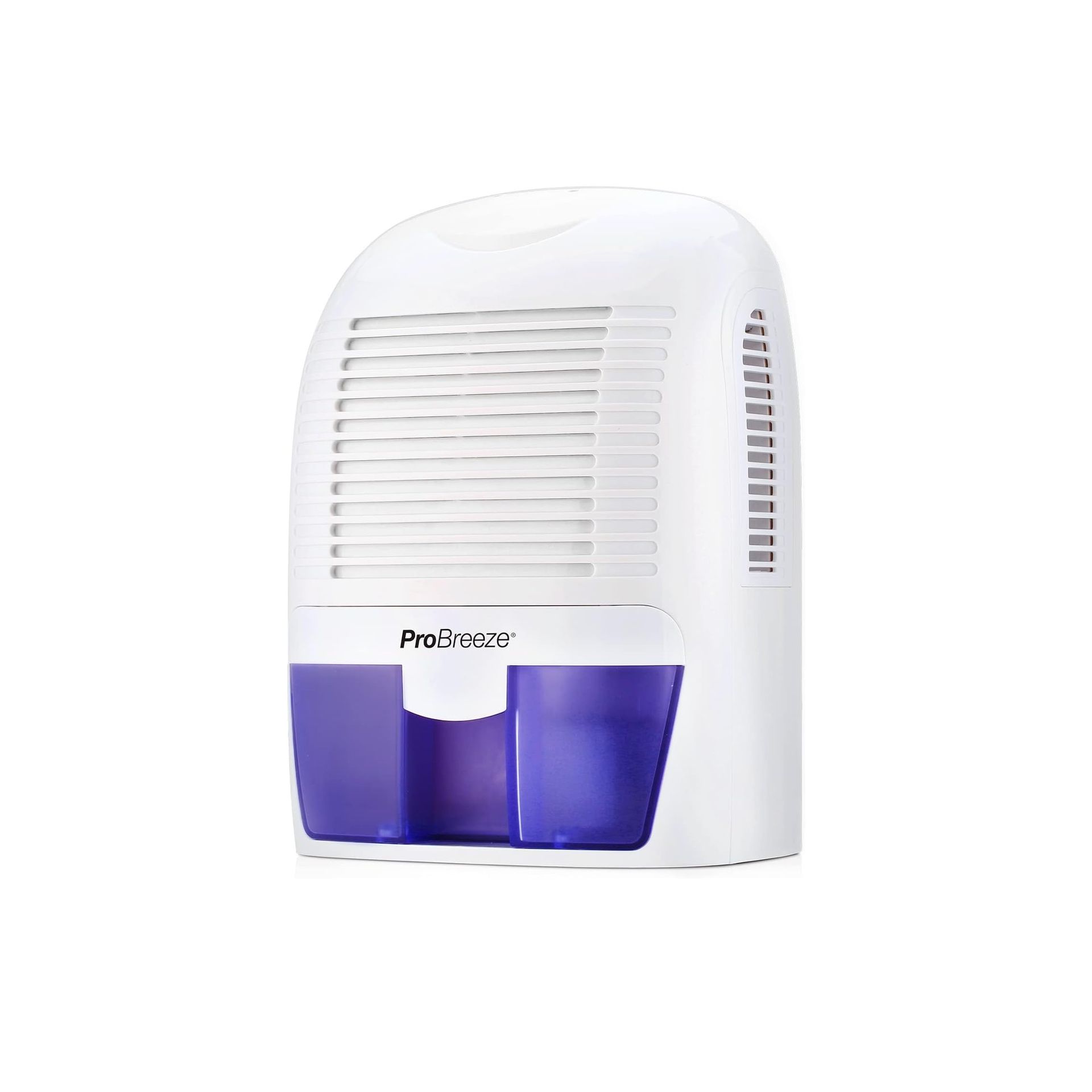
Best low cost dehumidifier
Affordable, compact, easy to use, with low running costs of just 1p per hour, we think this is one of the best low cost dehumidifiers for small spaces. It has a low extraction rate compared to more powerful compressor dehumidifiers and only offers basic 'on or off' functionality, but in our tests its Peltier condenser worked well to eliminate window condensation and reduce moisture levels within rooms under 15m². Plus, its small stature means you easily can tuck it away on a shelf or bedside table.
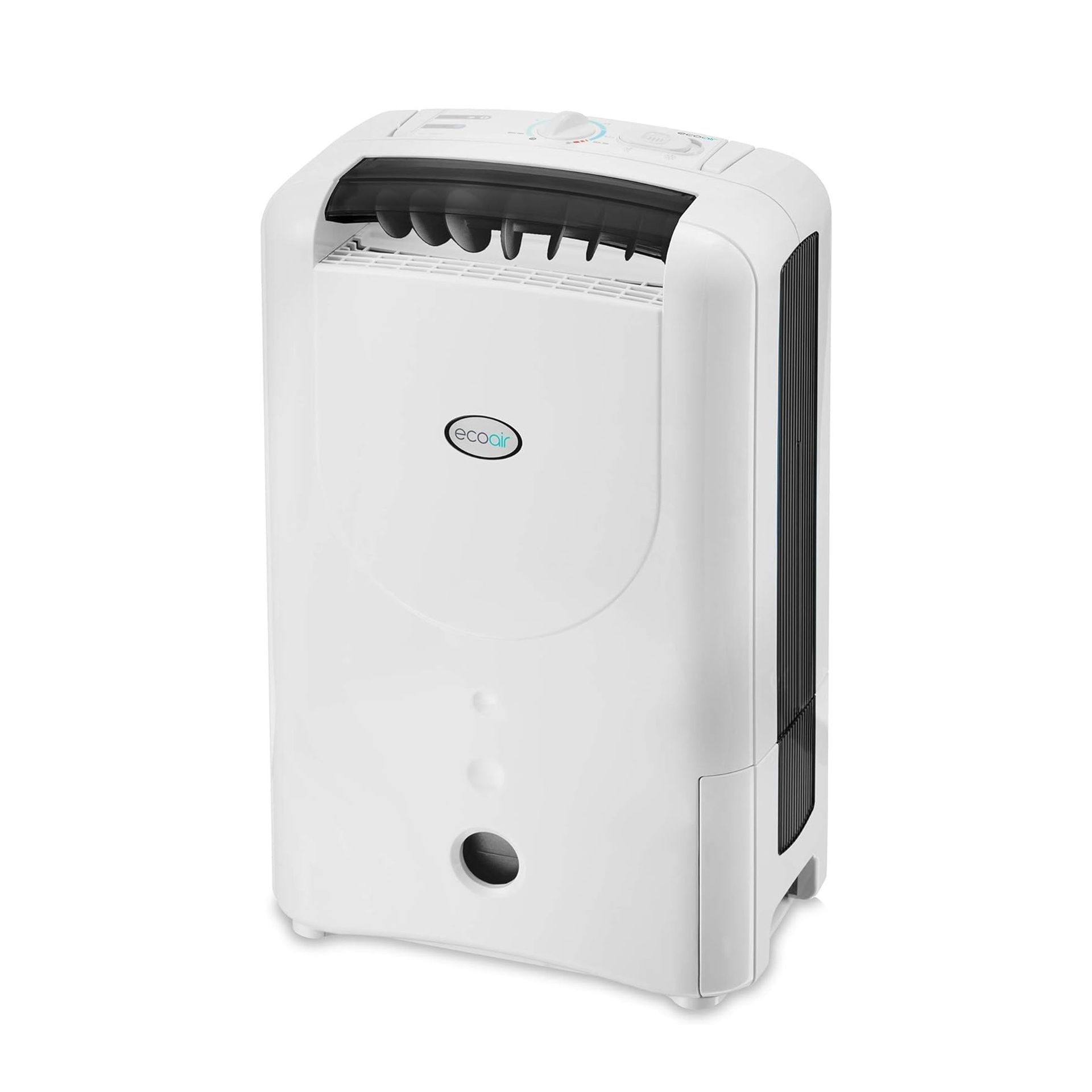
Best desiccant dehumidifier
A desiccant dehumidifier differs from a compressor or Peltier dehumidifier in that it's more efficient at lower temperatures. The EcoAir DD1 Simple MK3 can be operated in any space that's above 1°C, making it a great option for a garage, basement, or unheated rooms during the winter months. In our tests, it also performed brilliantly in normal conditions, making quick work of drying wet washing. The only downside is its price and higher running costs.

Best value large dehumidifier
If you’re looking for a dehumidifier that can clear moisture in a larger space or deal with significant damp levels within the home, then you need a dehumidifier with a high extraction rate. This Russell Hobbs model can extract 20L of moisture from the air per day, and whilst it doesn't quite offer as much functionality as the comparable 20L MeacoDry Arete One (and can't beat the Meaco on energy efficiency) it is a cheaper upfront investment.

Best small dehumidifier
If you’re looking for a small dehumidifier, then the Russell Hobbs RHDH1061G is about as compact as it gets, measuring just H22 x W14 x D14cm and weighing in at 0.9kg. Its size does mean it lacks power, extracting just 0.3L of moisture per day, and its 0.6L water tank means you'll be emptying it frequently. However, if you want a dehumidifier that's super small and lightweight, this mini option ticks the boxes.

Most stylish
It's fair to say that, in general, dehumidifiers aren't the most stylish of products, which is why De'Longhi's contribution to the market is something of a breath of fresh air amidst the usual boxy white plastic designs. The AriaDry is available in three models with either 12, 14 or 16L extraction rates depending on your room sizes, and all offering a dedicated Laundry Mode for quick drying of wet washing, built-in carry handles, and anti-dust and anti-allergy filters.
Best dehumidifiers of 2023
Why you can trust Ideal Home Our expert reviewers spend hours testing and comparing products and services so you can choose the best for you. Find out more about how we test.
Best dehumidifier overall


Specifications
Reasons to buy
Reasons to avoid
The MeacoDry Arete One dehumidifiers are some of the best dehumidifiers we've tested. They're quiet, easy to use, work superbly and are very energy-efficient compared to other compressor models. Plus, all offer a built-in air purification function to improve air quality within the home in more ways than one.
Most importantly, they also do a superb job of getting rid of excess moisture in the air. There are four different sized dehumidifiers in the Arete One range, offering moisture extraction rates of 10, 12, 20 or 25 litres per day. That means it's easy to find the right option for your home size, and the level of moisture control you need. And, all come with generous water tank capacity that means you aren't constantly emptying them, plus an automatic shut-off function when the water tank is full.
There's also plenty of useful functionality on the models. The automatic Smart Humidity Mode works perfectly and is hassle-free, turning the dehumidifier on when moisture-levels rise and automatically shutting the appliance off when the desired humidity is reached so there's no wasted energy or expense. And in our tests, the Arete One reduced moisture levels in damp-prone rooms in a very short period of time.
Plus, the MeacoDry Arete One dehumidifier's Smart Laundry mode works brilliantly for drying washing indoors – wet laundry was dry in hours rather than the days it can usually take in the draughty Victorian terrace we tested the unit in.
The unit isn't the lightest or most compact we've tested, but then we wouldn't expect that from a machine this powerful. However, built-in wheels, a retractable carry handle, and cable tidy make it easier to move around the house and store neatly away when it's not in use.
Overall, this is a best-in-class dehumidifier that does a fantastic job of extracting moisture from the home and is one of the best dehumidifier for drying washing fast.
Read our full Meaco MeacoDry Arete One Dehumidifier review for more detail.
Best low cost dehumidifier


Specifications
Reasons to buy
Reasons to avoid
First up, it's worth making clear that this small dehumidifier has a low extraction rate compared to many others on our list. The ProBreeze 1500ml Mini Dehumidifier can extract just 0.5L of moisture from the air per day. For comparison, the lowest extraction rate offered within the MeacoDry Arete One range is 10L of moisture extraction per day.
This dehumidifier is designed for managing fairly low moisture levels in small rooms up to 15m² or 2200 cubic feet, so it isn't going to cope with major damp issues or be able to control humidity within an entire house like larger capacity dehumidifiers. That said, the ProBreeze 1500ml Mini dehumidifier still impressed us during testing, and as long as you don't expect too much of it, this mini dehumidifier has a lot of plus points, not least its affordability.
Its Peltier condenser isn't as powerful as a compressor dehumifier and can only be used in rooms heated to 15-35°C. But, that means this dehumidifier is small, lightweight, and really easy to pick up and move around the home – perfect for small rooms that are short on space as you don't need to give up vital floor space to it, it can be placed on a window sill, shelf, or sideboard.
The lack of compressor also means our tester found it quieter than most, emitting a low background hum whilst it was operating that she found easy enough to ignore. Plus, the Peltier design makes for low energy use compared to a more power-hungry compressor or desiccant dehumidifier. The 40W ProBreeze 1500ml Mini Dehumidifier costs just 1p per hour to run at current energy costs.
It lacks functionality – as you might expect from its low price point – so this dehumidifier is either on or off, there are no controls beyond that. But, that does make it extremely easy to use. And considering its low moisture extraction rate, its water tank capacity is generous at 1.5L so you won't need to empty it as often as many other small dehumidifiers at this price point. Plus, the automatic shut-off when the water tank is full is great for piece of mind.
Overall, it's not the most powerful dehumidifier you can buy, and it can't cope with high moisture levels – we found it made little difference when drying wet washing for example. However, it did a great job of clearing condensation on windows and managing moisture levels in a small bedroom when left running overnight.
Its compact design that means it easily fits on a bedside table, relatively generous water tank, easy-to-use operation, low running costs, and affordable price tag means we think it's one of the best dehumidifiers under £100 – an ideal low cost dehumidifier for any small room where you want to combat excess moisture without breaking the bank.
Read our full ProBreeze 1500ml Mini Dehumidifier review for more detail.
Best desiccant dehumidifier


Specifications
Reasons to buy
Reasons to avoid
Unlike a compressor dehumidifier that passes air over a cold coil to condense the water from it, a desiccant dehumidifier uses a 'desiccant chemical' to absorb the moisture from the air. As a result, desiccant dehumidifiers are the best option for rooms that are likely to fall below 15°c, as at lower temperatures compressor and Peltier models can struggle to work efficiently.
The EcoAir DD1 Simple MK3 Dehumidifier can extract up to 7.5 litres of moisture per day in cold temperatures as low as 1ºc, so it's a very useful option for conservatorys, basements or garages that don't have dedicated heating, as well as unheated rooms in the home during winter months.
That said, in our tests it also worked brilliantly during normal use, quickly reducing humidity and making fast work of drying wet washing. This is helped by the warm air the Simple MK3 kicks out whilst running. EcoAir says that in general 'desiccant dehumidifiers emit warmer air (approx. 3-5 degrees celsius warmer than the ambient air) than compressor models' which can make a desiccant dehumidifier a particularly good choice for drying wet laundry indoors.
As it's name would suggest, the Simple MK3 is also very simple to set-up and operate with easy-to-use manual controls. For its price, we just found it lacked the style and added functionality of the MeacoDry Arete One – the Arete One's Smart humidity mode is particularly useful for controlling humidity without any user input and saves on energy use and running costs.
Infact, along with the higher price ticket, running costs are one of the biggest cons with this product. The 7.5L DD1 Simple MK3 uses 300-580W of electricity compared to the 10L MeacoDry Arete One's 129-199W range, which means the EcoAir model costs between 9p and 17p per hour to run at current energy prices, compared to the Meaco Arete's average of 5p per hour.
However, if you're looking for a dehumidifier for use in a cold climate, the EcoAir DD1 Simple MK3 Dehumidifier's 1ºc operating temperature is hard to beat.
Read our full EcoAir DD1 Simple MK3 Dehumidifier review for more detail.
Most affordable large dehumidifier


Specifications
Reasons to buy
Reasons to avoid
If you’re looking for a dehumidifier that can clear moisture in a larger space or deal with significant damp levels within the home, then you need a dehumidifier with a high extraction rate.
The cheapest and smallest dehumidifiers on the market can often only extract 0.5L of water from the air per day – in many cases even less – but larger and more powerful dehumidifiers can extract up to 25L per day which can make a huge difference to your home's health if you struggle with damp issues and condensation.
The downside is that you'll pay more the more powerful a dehumidifier is.
The Russell Hobbs RHDH2002 20L dehumidifier is one of the most affordable large dehumidifiers we've come across. This appliance can extract 20 litres of water from the air per day, and comes in significantly cheaper than comparable options like the best-in-class MeacoDry Arete One 20L dehumidifier that currently costs around £80 more upfront.
Just like the MeacoDry Arete One, as well as an impressive extraction rate the Russell Hobbs RHDH2002 20L dehumidifier has some great features, including an easy-to-read LED screen that displays current humidity levels and a useful Smart mode that monitors the humidity levels for you, turning the dehumidifier on and off as soon as it rises above the recommended home humidity range between 45%~55% for more economical (and hassle-free) use. There's also auto-shut off functionality when the water tank is full.
However, there are downsides. The Russell Hobbs RHDH2002 20L dehumidifier's water tank is fairly small at just 3L, which – especially compared to the 20L MeacoDry Arete One's 4.8L water tank – meant in our tests we were emptying it fairly frequently, and doing so without spilling water was difficult as the tank gets almost full to the top before auto-shut off kicks in.
And, whilst this Russell Hobbs number is cheaper upfront, running costs are higher, with the 20L dehumidifier using 440W of energy compared to Meaco's 20L Arete One which uses 216W on average. Plus, the Arete One offers a built-in air purifier which this model does not.
All that said, the Russell Hobbs RHDH2002 20L dehumidifier still impressed our review team during testing. So, if you’re looking for a powerful dehumidifier with a cheaper upfront cost, the Russell Hobbs RHDH2002 20L is well worth considering.
Read our full Russell Hobbs RHDH2002 20L review for more detail.
Best small dehumidifier


Specifications
Reasons to buy
Reasons to avoid
If you’re looking for a small dehumidifier, then the Russell Hobbs RHDH1061G Portable Dehumidifier is about as compact as it gets, measuring just H22 x W14 x D14cm and weighing in at 0.9kg.
Its compact dimensions and lightweight build do indeed make for excellent portability, and it comes in at a very affordable price point. Although, its currently not quite as affordable as the ProBreeze 500ml Compact Mini Dehumidifier that is still our top pick for the cheapest dehumidifier you can buy.
Just like the ProBreeze 500ml, the Russell Hobbs RHDH1061G’s tiny build does mean that you'll sacrifice powerful performance with this option. As you might expect from its smaller proportions, this mini dehumidifier's extraction rate and tank capacity don't compare to larger dehumidifiers on this list. Measured against the MeacoDry Arete One dehumidifier's powerful extraction rates of 10, 12, 20, or 25 litres of water from the air each day, the Russell Hobbs RHDH1061G can only extract 0.3 litres of water per day, and its 0.6L tank capacity means you'll need to empty it frequently. However, that is still slightly better performance compared to other small dehumidifiers, like the ProBreeze 500ml Compact Mini Dehumidifier‘s 0.25L extraction rate and 0.5L water tank.
If you want a dehumidifier of a similar power and price point, the slightly more expensive ProBreeze 1500ml Mini Dehumidifier remains our best budget buy, offering a better extraction rate of 0.5L and a larger 1.5L water tank, which means you won’t be emptying it quite so frequently. That said, the ProBreeze 1500ml Mini Dehumidifier is also larger in size, measuring H30 x W22 x D16cm compared to the Russell Hobbs' H22 x W14 x D14cm frame. And, the ProBreeze 1500ml is twice the weight, weighing in at 1.85kg.
So, if you’re after the smallest dehumidifier on the market, we think the Russell Hobbs RHDH1061G wins the accolade of best small dehumidifier, with good all round performance for its size housed in one of the smallest builds on the market – along as you don't expect too much from that 0.3L extraction rate.
Read our full Russell Hobbs RHDH1061G Portable Dehumidifier review for more detail.
Most stylish

6. De'Longhi Tascuigo AriaDry Multi Dehumidifier
Specifications
Reasons to buy
Reasons to avoid
It's fair to say that most dehumidifiers aren't the most stylish of appliances, which is why the De'Longhi Tascuigo AriaDry Multi Dehumidifier is something of a breath of fresh air amidst the usual boxy white plastic designs.
The De'Longhi Tascuigo AriaDry DEX216F is the largest model in the range and able to extract 16L of water from the air per day, and although the tank capacity isn't the largest, at 2.1L it still offers adequate capacity] This multi-purpose appliance also has an air purifier function with a double filtration system that can remove dust and other allergens from the air, plus a dedicated Laundry Drying function.
The sleek and modern unit with navy blue exterior stands out from the crowd in all the right ways, and whilst it doesn't have built-in wheels like most dehumidifiers of this size, the integrated carry handle and mid-weight build make it relatively easy to transport from room to room. If you want a more compact build, then there is also a 12L and 14L model available.
The only real downside is the premium you pay for that design-led exterior, with the MeacoDry Arete One Dehumidifier & Air Purifier offering better value in terms of extraction and tank capacity for the price.
In-stock dehumidifiers
As cold weather creeps in, the demand for dehumidifiers rises fast, with many people looking to shop for one of these appliances to banish mould and to help dry clothes faster. As such it's well worth investing in a dehumidifier out of season in spring or summer when stock levels are healthier.
However, if you come to shop when stock is limited, these are the retailers where you're most likely to find a dehumidifier in stock.
- Shop Amazon dehumidifiers
- Shop Argos dehumidifiers
- Shop Currys dehumidifiers
- Shop John Lewis dehumidifiers
- Shop Robert Dyas dehumidifiers
- Shop Very dehumidifiers

How to choose
Finding the best dehumidifier for your home depends a lot on the type of moisture issue you're trying to solve, so it's always worth speaking with the customer service department of the manufacturer you're hoping to buy from to ensure you have the right model for your needs.
However, to help give an overview, here are some key facts it's useful to know before searching for the best dehumidifier for the task in hand.
What are the main types of dehumidifier?
1. Compressor (sometimes also called refrigerant or condenser) dehumidifiers
Compressor dehumidifiers tend to be the most common design available in the UK. They work by drawing air into the dehumidifier via a fan, and then running the air over over cold coils to condense the moisture from it, whereby the condensed water is collected in a water tank. The coils are kept cool by refrigerant which means the unit also needs a compressor built in. The only downside of compressor dehumidifiers is that they need the air to be warm for this process to work. Most will work above 5°C, but they're most efficient at an ambient temperature of around 20°C (depending on the individual model).
2. Desiccant dehumidifiers
A desiccant dehumidifier differs in that it uses an absorbent material or chemical dessicant to extract moisture from the air. This means they can operate efficiently in lower temperatures, down to just 1°C, and are useful for garages, basements, conservatorys, or unheated rooms in the house over winter. However, they're usually more expensive both upfront and in terms of running costs than a compressor dehumidifier, so unless you're looking to remove damp at cold temperatures you're generally best off with a compressor model.
3. Peltier dehumidifiers
Like compressor dehumidifiers, Peltier dehumidifiers also use a condensation process to remove moisture from the air. However, they do this via a thermoelectrical process rather than using refrigerant and a compressor, so they're generally a lot quieter and more economical to run. The downside is that they're far less powerful, so Peltier dehumidifiers tend to very small and best for localised areas of moisture – they won't be powerful enough to help with damp in a large room or entire house.
Once you've decided which type of dehumidifier is the best fit for your needs, next up you'll want to consider extraction rates.
What extraction rate should a dehumidifier have?
A dehumidifier's extraction rate is an average of how much moisture it can remove from the air during a given timeframe. Most commonly this is measured in litres per day, so an extraction rate of 10L/per day means the dehumidifier should be able to extract 10 litres of moisture within 24 hours if running continuously. In practice, this also depends on the humidity levels of the room, and the ambient temperature.
Generally speaking, you'll find compressor dehumidifiers that offer 10, 12, 14, 16, 18, 20, and 25L extraction rates. The higher the extraction rate the more powerful the machine will be, but generally also the larger, heavier, more expensive, and more expensive to run the dehumidifier will be.
You'll also find plenty of dehumidifiers that offer much lower extraction rates, with some of the smallest dehumidifiers extracting just 0.3L of moisture per day.
The right dehumidifier for you will depend on your room size, the scale of your moisture issues, and how quickly you want the appliance to remove moisture. Most dehumidifiers come with a recommended room size listed, so use this as a guage when choosing the best dehumidifier for your home.
It's also important not to confuse the extraction rate with a dehumidifiers water tank capacity. As both are generally measured in litres or millilitres this can sometimes cause confusion.
The tank capacity dictates how much water the water tank of the dehumidifier can hold before it needs emptying. A larger tank capacity – such as the MeacoDry Arete One Dehumidifier's generous 2.5L or 4.8L tanks – means you won't be emptying it as frequently.
Most of the dehumidifiers in our round-up feature automatic shut-off functions that mean they automatically switch off and sound an alarm or activate a warning light once the tank is full. However, a small capacity tank potentially increases the amount of time the dehumidifier will be out of operation before you notice and empty the tank.
It's also worth considering noise levels and energy consumption before you invest in a dehumidifier.
What's the quietest dehumidifier?
Most dehumidifiers have their noise levels listed in their specifications, although in practice we didn't find that much variation between models, with most falling somewhere between 35 and 45dB.
In our tests, Peltier condenser dehumidifiers proved the quietest, which is why the Peltier-powered ProBreeze 1500ml Mini Dehumidifier is our top pick for the bedroom. However, Peltier dehumidifiers are also the least powerful, so the relatively quiet MeacoDry Arete One Dehumidifier is our top choice for a low volume compressor dehumidifier.
As for energy consumption, you can find out more in our guide to 'How much does it cost to run a dehumidifier?'. However, the easiest way to find out is to compare each dehumidifier's wattage. The higher the number of Watts the appliance requires, the more expensive running costs will be.
Lastly, there's extra functionality to consider. The best dehumidifiers you can buy offer a Smart mode. That means you can leave the dehumidifier running and its sensors will detect the humidity levels and switch the machine on and off to keep humidity within your desired range. That saves energy (and money) as the appliance isn't running if it doesn't need to be.
Many also offer a Laundry Drying mode that can give the appliance an extra boost when you're trying to dry wet washing indoors without ending up with that dreaded damp smell.

FAQs
When's the best time to buy a dehumidifier?
Dehumidifier sales start to climb as soon as the autumn weather rolls in and our homes start to struggle with damp, and more of us are attempting to dry washing indoors. As such, the best dehumidifiers can be at their cheapest during the summer when sales are slow and retailers are more likely to discount. However, during these months stock can be harder to find.
Another good bet is waiting for Amazon Prime Day dehumidifier deals to land – keep an eye on our Amazon Prime Day deals page to see when the next event is due to start – or to shop Black Friday dehumidifier deals at the end of November when the Black Friday price-slashing extravaganza tends to produce some extremely good prices. Our Black Friday deals page rounds up all of the lowest prices as they're launched.
If you're looking for a cheap dehumidifier then make sure to check out our dehumidifier deals page which has round-ups of all the best sale prices currently available.
Do I need a dehumidifier?
If you're wondering how to get rid of mould in a poorly ventilated room, or trying to combat excess moisture or humidity inside the home, then a dehumidifier can be a useful tool in your arsenal.
As Chris Michael, Managing Director of the air quality brand Meaco says, inside the home, 'excess moisture in the air can come from drying clothes in the house, boiling vegetables, putting the kettle on, bathing, showering, open flame gas style heating, damp clothing, breathing, and the damp British weather.'
Regular ventilation like opening the windows and doors in your home or turning on extractor fans in the kitchen and bathroom is key to removing the build-up of mould-causing moisture. (Top tip: this is how long to keep windows open to stop mould, as recommended by the experts). However, if your home doesn't have adequate ventilation, or it's winter and you don't want to open windows to avoid letting your heating escape, then a dehumidifier can help keep moisture levels in check.
That's why a dehumidifier is particularly useful to pair with one of best heated clothes airers in winter; it will suck the moisture out of the air as your clothes dry, speeding up drying times even more and reducing the risk of mould-creating condensation on walls and windows.
If you have more serious damp issues, then although a dehumidifier can help to reduce the problem and improve the air quality in your home, it won't prevent the damp from occurring in the first place, so it's important to get to the root of the issue. Read our guide to how to get rid of damp for help in identifying the cause of your damp issues, and how to treat them.
As cleaning expert, Matthew Harrison from Price Your Job explains, if you house suffers from more serious damp issues, then 'to prevent future mould problems, you should consider draught-proofing and other jobs which will prevent moisture from entering your home in the first place'.
Do dehumidifiers help to dry clothes?
Yes, alongside investing in one of the best heated clothes airers on the market, a dehumidifier can help dry clothes indoors. That's because it sucks up the moisture that wet washing releases as it dries, therefore helping to speed up drying times.
'When I tested the laundry function on the Russell Hobbs 20L dehumidifier to dry t-shirts in a small bedroom, it definitely sped up the drying time' said our reviewer. 'The T-shirts closest to the dehumidifier dried in 3 hours, but those further away took about double that time to completely dry'.
How we test
You'll find full details of the Ideal Home review process on our how we test page.
Our team of reviewers tested a host of the bestselling dehumidifiers to compile this guide. We compared performance indicators such as moisture extraction rate, tank capacity and how often each model needed emptying, ease of use of controls, aesthetics, and, of course, the price point to find the best value dehumidifiers. We also considered the size and weight of each appliance to find the most portable options, plus each model's noise levels.

If there are any products that we haven't managed to test in person, or the product didn't achieve over 4 out of 5 stars, then they won't have an Ideal Home Approved badge. However, you can rest assured we've done thorough research on their technical specifications and read multiple happy – and not-so-happy – customer reviews to narrow down our suggestions to only the best-in-class.
Get the Ideal Home Newsletter
Sign up to our newsletter for style and decor inspiration, house makeovers, project advice and more.

After studying Print Design at Winchester School of Art, Amy spent multiple years working in the interior industry, including styling and visual merchandising for many well-known brands. She’s now Decor Editor at Ideal Home, offering advice on creating your dream interior, whether that's choosing the perfect shade of paint, investing in a new sofa, or sourcing on-trend and sustainable products for the home. She also writes about all things interior for Livingetc, Homes & Gardens, and Real Homes, and brings her design knowledge outdoors at Gardeningetc, where she advises on what to look for when shopping for the best garden furniture and how to create a practical and stylish outdoor living area.
- Luke EdwardsContributor
- Rachael Phillips
-
 6 genius IKEA hacks for kids bedrooms that you'll definitely want to try
6 genius IKEA hacks for kids bedrooms that you'll definitely want to tryEveryone needs a good IKEA hack – especially when it comes to a kids bedroom
By Kayleigh Dray
-
 Where to buy Christmas decorations like a Homes Decor Editor for a very merry home this festive season
Where to buy Christmas decorations like a Homes Decor Editor for a very merry home this festive seasonLooking to give your home a twinkling makeover this December? Here's our pick of where to buy Christmas decorations
By Kayleigh Dray
-
 Dunelm's cult teddy bedding is back for winter, and shoppers are obsessed
Dunelm's cult teddy bedding is back for winter, and shoppers are obsessedHave you tried Dunelm's cult teddy bedding yet?
By Kayleigh Dray
-
 We've sniffed out the 6 October Prime Day candle deals to make your home smell better than ever
We've sniffed out the 6 October Prime Day candle deals to make your home smell better than everDid you know that you can shop for candles over Prime Day? These our the Ideal Home team's favourites to get your home smelling divine
By Molly Cleary
-
 When does Amazon Prime Day End? Time is running out fast to grab a bargain
When does Amazon Prime Day End? Time is running out fast to grab a bargainAmazon Big Deal Day (a.k.a Amazon Prime Day 2.0) is coming to an end very soon and time is running out to grab a deal
By Rebecca Knight
-
 LIVE: October Prime Day air fryer deals 2023 you can still shop now the event is over
LIVE: October Prime Day air fryer deals 2023 you can still shop now the event is overThese are the Amazon Prime Day air fryer deals to shop, as tried and tested by the Ideal Home team
By Molly Cleary
-
 October Amazon Prime Day deals 2023 might be over, but you can still shop these discounts
October Amazon Prime Day deals 2023 might be over, but you can still shop these discountsWe round up the last of the best Amazon Prime Day deals if you're still looking to shop
By Molly Cleary
-
 LIVE: October Amazon Prime Day deals 2023 – the deals still running after the close of the event
LIVE: October Amazon Prime Day deals 2023 – the deals still running after the close of the eventAll the best Prime Big Deals Day discounts on Ninja air fryers, Shark vacuums, dehumidifiers and many more bestselling home and appliance brands
By Molly Cleary
-
 7 refills I’m stocking up on this Amazon Prime Day to save me some serious money in the long run
7 refills I’m stocking up on this Amazon Prime Day to save me some serious money in the long runYou’ll never be without these household essentials again
By Lauren Bradbury
-
 Don't fall for the hype! Here are the Prime Day purchases actually worth it and with over £100 off
Don't fall for the hype! Here are the Prime Day purchases actually worth it and with over £100 offAs a shopping editor, I'm here to tell you what to actually buy
By Holly Cockburn
-
 9 things I always bulk buy on Amazon Prime Day to save money all year round
9 things I always bulk buy on Amazon Prime Day to save money all year roundSave not only money but also endless trips to the supermarket
By Jullia Joson



